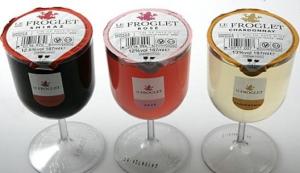 Having been exiled to the UK with work for a few months in my completely non-wine-related day job, I thought it would be a good opportunity to see what’s out there in terms of wine innovation and perhaps preview what might be the next thing to hit our lovely green shores. Do forgive me if some, if not all of the breakthroughs that I report on have already reached Eire.
Having been exiled to the UK with work for a few months in my completely non-wine-related day job, I thought it would be a good opportunity to see what’s out there in terms of wine innovation and perhaps preview what might be the next thing to hit our lovely green shores. Do forgive me if some, if not all of the breakthroughs that I report on have already reached Eire.
I’ve already spotted a few quirks down in London which I will bring to you as I can, and I stumbled upon another gem in Marks and Spencer in Leeds train station today. No I’m not going to talk about the new Percy Pig yoghurt (which is nowhere near as good as it sounds), or my glee at passing Elland Road once more on the train.
 I’m talking about the ‘cup-a-wine’ that M&S have recently launched in their UK stores. It is essentially a sealed plastic glass of wine. Not one for the purists; it was universally dismissed on Dragons’ Den when its inventor tried to hawk them the idea in 2009. It comes in a 187ml reusable recyclable plastic glass (made by Wine Innovations) and is covered with a foil seal which the label states must be drunk within 3 months of purchase. This one is a Vin de Pays D’Oc, oddly called “Le Froglet” and comes in Shiraz, Chardonnay and Rosé flavours. It costs £2.25 a glass.
I’m talking about the ‘cup-a-wine’ that M&S have recently launched in their UK stores. It is essentially a sealed plastic glass of wine. Not one for the purists; it was universally dismissed on Dragons’ Den when its inventor tried to hawk them the idea in 2009. It comes in a 187ml reusable recyclable plastic glass (made by Wine Innovations) and is covered with a foil seal which the label states must be drunk within 3 months of purchase. This one is a Vin de Pays D’Oc, oddly called “Le Froglet” and comes in Shiraz, Chardonnay and Rosé flavours. It costs £2.25 a glass.
Never one to shirk a wine challenge, I decided to give all three a go, sure the £6.75 would barely dent my fat daily expense allowance, and hey, Leeds wasn’t exactly buzzing on a dull, rainy evening in West Yorkshire.
 First up, the Chardonnay. The initial sniff of the wine nearly knocked me out. They really fill wine up to the brim and I couldn’t swirl it around to release more noxious aromas, so I adjourned to a real glass. This wine had hints of typical Chardonnay on the nose; butter, tropical fruits, lemon. But there was something stale or unnatural overpowering it. I closed my hotel window in case the Leeds air was affecting my judgement but alas no difference. It tasted equally revolting – I first got Lilt which then evolved into paint, the type when in playschool you thought was a good idea to drink. For the record, blue paint was my favourite. It left my mouth tasting like I’d spent the night in Leggs. 2/10
First up, the Chardonnay. The initial sniff of the wine nearly knocked me out. They really fill wine up to the brim and I couldn’t swirl it around to release more noxious aromas, so I adjourned to a real glass. This wine had hints of typical Chardonnay on the nose; butter, tropical fruits, lemon. But there was something stale or unnatural overpowering it. I closed my hotel window in case the Leeds air was affecting my judgement but alas no difference. It tasted equally revolting – I first got Lilt which then evolved into paint, the type when in playschool you thought was a good idea to drink. For the record, blue paint was my favourite. It left my mouth tasting like I’d spent the night in Leggs. 2/10
 Next, the Rosé. It couldn’t get any worse, could it?! Thankfully it didn’t. Learnt my lesson from the last time and gave it a minute before poking my nose near it. It smelt rather pleasantly of sweet, candied strawberry. This had me thinking it was Grenache-dominated but the 12% alcohol might suggest otherwise. On the palate – not much. Faint red fruits, perhaps a touch of oak. Perfectly pleasant, quaffable wine if I’m being honest. The 187ml reusable recyclable plastic glass turns out to be problematic however – the wine takes on a chemical character if you sip directly from it (must be the sticky stuff the glues the foil to the glass). The rim is also quite sharp, much to my chagrin as the glass took a small piece of lip with it on its way back down to the table. 5/10 (1 mark deducted for assault)
Next, the Rosé. It couldn’t get any worse, could it?! Thankfully it didn’t. Learnt my lesson from the last time and gave it a minute before poking my nose near it. It smelt rather pleasantly of sweet, candied strawberry. This had me thinking it was Grenache-dominated but the 12% alcohol might suggest otherwise. On the palate – not much. Faint red fruits, perhaps a touch of oak. Perfectly pleasant, quaffable wine if I’m being honest. The 187ml reusable recyclable plastic glass turns out to be problematic however – the wine takes on a chemical character if you sip directly from it (must be the sticky stuff the glues the foil to the glass). The rim is also quite sharp, much to my chagrin as the glass took a small piece of lip with it on its way back down to the table. 5/10 (1 mark deducted for assault)
 Finally the Shiraz. Its unappealing nose of pepperami, combined with the usual spice, liquorice and black fruit of the grape had me nervous. On the palate – rough, uneven tannins, feeble black fruit, and AGAIN a hint of paint (who the hell was meant to be watching me back then?) No length on the finish; in sum a limp, horrid wine. 3/10
Finally the Shiraz. Its unappealing nose of pepperami, combined with the usual spice, liquorice and black fruit of the grape had me nervous. On the palate – rough, uneven tannins, feeble black fruit, and AGAIN a hint of paint (who the hell was meant to be watching me back then?) No length on the finish; in sum a limp, horrid wine. 3/10
For me the jury’s out on this format – while I don’t necessarily hate the idea, I hated two of the three wines I tasted this evening. And if you multiply £2.25 by 4, your bottle’s worth is costing you 9 pounds, or nearly 11 euro which is a crime for that standard of wine. There clearly is a place for this type of format: at concerts and sporting events (where real glass can be a hazard/weapon); on cheap airlines; and trendy parks and commons around South West London. Whatever the place of consumption, M&S are apparently struggling to meet demand, so to that, I must raise my plastic glass!



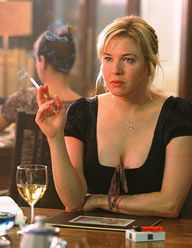 Merlot – from the old French word for young blackbird; seemingly the only creature that loves the grape resolutely, unaffected by films or fads or medical studies. Amongst us humans however, it is loved and loathed in equal measure.
Merlot – from the old French word for young blackbird; seemingly the only creature that loves the grape resolutely, unaffected by films or fads or medical studies. Amongst us humans however, it is loved and loathed in equal measure. 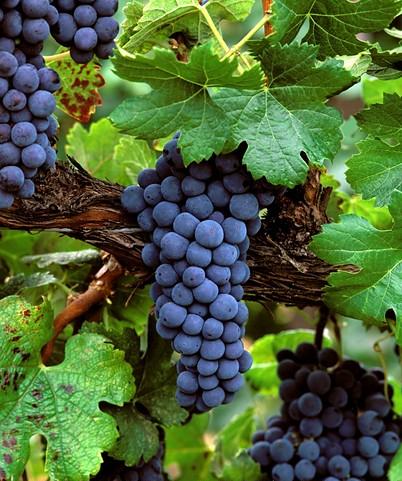 Merlot really took off after an infamous 1991 US news program broke a story around the beneficial effects of red wine on health. They put forward the ‘
Merlot really took off after an infamous 1991 US news program broke a story around the beneficial effects of red wine on health. They put forward the ‘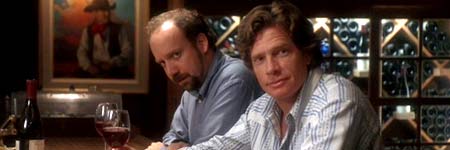 The film’s effect on wine industry was profound. By the time the film was awarded an Oscar three months after its release, sales of Merlot in the US had already dipped 2%, with Pinot Noir jumping 16%. People across the country rushed to their local shops and supermarkets demanding the ‘Sideways wine’. Retailers capitalised by running Pinot Noir promotions and festivals. Many winemakers immediately yanked out their Merlot vines and replaced them with Pinot Noir. In fact, in 2003 wine makers in California planted 840 acres of Merlot, but in 2008 only planted 39. Compare this with Pinot Noir plantings in the same period: from 600 acres in 2003 to 1,796 in 2008!
The film’s effect on wine industry was profound. By the time the film was awarded an Oscar three months after its release, sales of Merlot in the US had already dipped 2%, with Pinot Noir jumping 16%. People across the country rushed to their local shops and supermarkets demanding the ‘Sideways wine’. Retailers capitalised by running Pinot Noir promotions and festivals. Many winemakers immediately yanked out their Merlot vines and replaced them with Pinot Noir. In fact, in 2003 wine makers in California planted 840 acres of Merlot, but in 2008 only planted 39. Compare this with Pinot Noir plantings in the same period: from 600 acres in 2003 to 1,796 in 2008! The delicious irony of the whole film is that by the film’s end, *WARNING! PLOT SPOILER!* we see a dejected and depressed Miles in a grotty fast food cafe, drinking his prized bottle of 1961 Chateau Cheval Blanc from a paper cup. In fairness, Miles wouldn’t be the first person to make the mistake of roundly denouncing Merlot yet lavish praise on a Saint Emilion wine like Cheval Blanc – this particular bottle would have contained 39% Merlot, and 0% Pinot Noir.
The delicious irony of the whole film is that by the film’s end, *WARNING! PLOT SPOILER!* we see a dejected and depressed Miles in a grotty fast food cafe, drinking his prized bottle of 1961 Chateau Cheval Blanc from a paper cup. In fairness, Miles wouldn’t be the first person to make the mistake of roundly denouncing Merlot yet lavish praise on a Saint Emilion wine like Cheval Blanc – this particular bottle would have contained 39% Merlot, and 0% Pinot Noir.
 I have always held a special affinity with Alsace. I often fondly reflect on the incredible Erasmus year I spent in the Alsatian capital, Strasbourg, the highlights of which included chasing Racing Strasbourg FC around Europe in the UEFA Cup, and chasing Colombians and Mexicans around the nightclubs of the city. Other must-sees included daily strikes, the 2005 riots in la banlieue and our landlord who proudly declared upon our arrival “Je deteste les irlandais!”. Otherwise Strasbourg is famous for its ancient cathedral, the delightful Petit France quarter, and the honour of being home to the European Parliament once a month, when the bureaucratic gravy train of politicians, diplomats, officials, journalists, researchers and protestors descend on the city, all to satisfy the French’s desire to retain a significant European institution in the country. What I also developed during my year there was a penchant for Riesling, Pinot Gris and Gewürztraminer. For in Alsace these wines reach heights of complexity and character that it is almost unmatched anywhere else in the world.
I have always held a special affinity with Alsace. I often fondly reflect on the incredible Erasmus year I spent in the Alsatian capital, Strasbourg, the highlights of which included chasing Racing Strasbourg FC around Europe in the UEFA Cup, and chasing Colombians and Mexicans around the nightclubs of the city. Other must-sees included daily strikes, the 2005 riots in la banlieue and our landlord who proudly declared upon our arrival “Je deteste les irlandais!”. Otherwise Strasbourg is famous for its ancient cathedral, the delightful Petit France quarter, and the honour of being home to the European Parliament once a month, when the bureaucratic gravy train of politicians, diplomats, officials, journalists, researchers and protestors descend on the city, all to satisfy the French’s desire to retain a significant European institution in the country. What I also developed during my year there was a penchant for Riesling, Pinot Gris and Gewürztraminer. For in Alsace these wines reach heights of complexity and character that it is almost unmatched anywhere else in the world.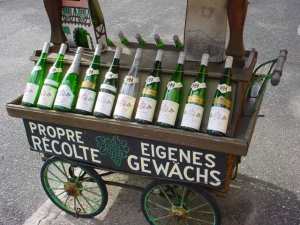 The first thing you’ll notice about a bottle of Alsatian wine is the heavy Germanic influence. Alsace is the only appellation in France which permits varietal labelling, i.e. the law permits that the producer can helpfully print the grape variety on the label. This was a German tradition long before the New World wines were onto it. Every bottle of wine will also come in the traditional German flûte shape. This can be a bit of a nuisance selling wines abroad – the consumer has been slow to change their perception of these wines being sickly and sweet in the old Blue Nun/Black Tower style, while retailers have sometimes had difficulty shelving and displaying the tall and slender bottles. I certainly remember them not fitting into the wine fridge in Donnybrook Fair when I worked there.
The first thing you’ll notice about a bottle of Alsatian wine is the heavy Germanic influence. Alsace is the only appellation in France which permits varietal labelling, i.e. the law permits that the producer can helpfully print the grape variety on the label. This was a German tradition long before the New World wines were onto it. Every bottle of wine will also come in the traditional German flûte shape. This can be a bit of a nuisance selling wines abroad – the consumer has been slow to change their perception of these wines being sickly and sweet in the old Blue Nun/Black Tower style, while retailers have sometimes had difficulty shelving and displaying the tall and slender bottles. I certainly remember them not fitting into the wine fridge in Donnybrook Fair when I worked there. Riesling is the most widely planted grape in the region, and is probably the best regarded. On the vine it’s a little green grape with freckles (my mom always said they were attractive!). It makes a dry, elegant and powerful wine, with stunning ability to age, taking on oily character with aromas of kerosene. Now you’ll probably wonder how drinking petrol is attractive, but it’s the ultimate and coveted expression of aged Riesling.
Riesling is the most widely planted grape in the region, and is probably the best regarded. On the vine it’s a little green grape with freckles (my mom always said they were attractive!). It makes a dry, elegant and powerful wine, with stunning ability to age, taking on oily character with aromas of kerosene. Now you’ll probably wonder how drinking petrol is attractive, but it’s the ultimate and coveted expression of aged Riesling.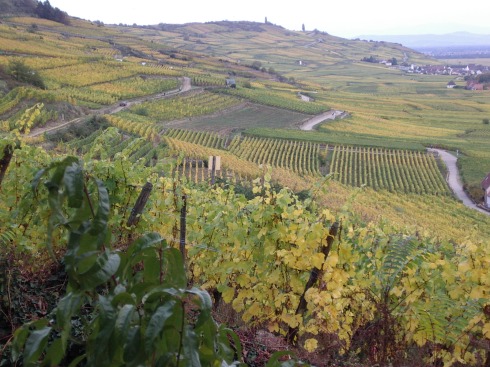 One of the best experiences that stuck with me from the year was travelling the Route des Vins. This is a 170 kilometre road taking you through 67 idyllic and picturesque communes that make up Alsace wine country. You’ll pass by fairytale castles, imposing mountains and gorges, mysterious forests, and beautiful rolling golden vineyards, and stop by wineries for tasting and buying of course. But what gives the region most of its charm are the villages themselves – entering places like Riquewihr, Ribeauvillé and especially Colmar you’d be forgiven for thinking you’ve stumbled into some sort of medieval time warp. Throughout history Alsace has constantly changed hands between the French and the Germans, and most recently during World War 2, thankfully most of the region’s villages escaped the war’s ravages. So the half-timbered houses, quaint churches and traditional Winstubs still stand, in the exact same way as they have done for centuries. I did the Route twice – once with the college where the objective was to get two busloads of international students as drunk as possible – and then with my parents where we rented a car and took the region in at a much slower and enjoyable pace, stopping to eat and drink at our leisure over the day. It was a truly wonderful day.
One of the best experiences that stuck with me from the year was travelling the Route des Vins. This is a 170 kilometre road taking you through 67 idyllic and picturesque communes that make up Alsace wine country. You’ll pass by fairytale castles, imposing mountains and gorges, mysterious forests, and beautiful rolling golden vineyards, and stop by wineries for tasting and buying of course. But what gives the region most of its charm are the villages themselves – entering places like Riquewihr, Ribeauvillé and especially Colmar you’d be forgiven for thinking you’ve stumbled into some sort of medieval time warp. Throughout history Alsace has constantly changed hands between the French and the Germans, and most recently during World War 2, thankfully most of the region’s villages escaped the war’s ravages. So the half-timbered houses, quaint churches and traditional Winstubs still stand, in the exact same way as they have done for centuries. I did the Route twice – once with the college where the objective was to get two busloads of international students as drunk as possible – and then with my parents where we rented a car and took the region in at a much slower and enjoyable pace, stopping to eat and drink at our leisure over the day. It was a truly wonderful day. Last weekend I spotted a
Last weekend I spotted a 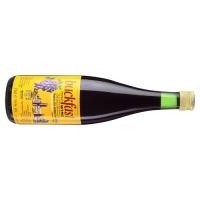 Ever since Benedictine monks invented the stuff in 1927, Buckfast has been getting students, bums, undesirables, yuppies, miscreants and whoever else “f*cked fast” for years. Its heady combination of alcohol, caffeine, price and sweetness make it an ideal solution to many of life’s problems – whether your intention is a) getting your buzz on before a night out, or b) trying to rid the bottle of its ghastly liquid so as to turn it into a deadly weapon.
Ever since Benedictine monks invented the stuff in 1927, Buckfast has been getting students, bums, undesirables, yuppies, miscreants and whoever else “f*cked fast” for years. Its heady combination of alcohol, caffeine, price and sweetness make it an ideal solution to many of life’s problems – whether your intention is a) getting your buzz on before a night out, or b) trying to rid the bottle of its ghastly liquid so as to turn it into a deadly weapon. I nearly killed my cousin with a wheel brace last time I drank a bottle. Got the wheel brace after breaking into an abandoned car. Great night though.
I nearly killed my cousin with a wheel brace last time I drank a bottle. Got the wheel brace after breaking into an abandoned car. Great night though. I apprehensively got out the glasses to taste the Buckfast. First observation was the handy screw cap stopper; so no excuses of cork taint affecting the wine. I poured what turned out to be a dull brown liquid, its legs sticking to the glass like a particularly clingy ex-girlfriend. It had pronounced sweet aromas of flat coke, soap, peachy honey and brown sugar, with subtle notes of Deep Heat. On the palate, it was disgustingly sweet, with low acidity and no tannins. Not a food wine then. The high alcohol burned the back of the throat, again the flat coke taste came out, or rather a brown Mr Freeze when you were young and it melted on you. I got the same stickiness on my hands and around my mouth! I also detected syrupy tinned fruit like pineapples or apricots. The finish was long, but again the sticky sweetness on my gums and teeth dominated.
I apprehensively got out the glasses to taste the Buckfast. First observation was the handy screw cap stopper; so no excuses of cork taint affecting the wine. I poured what turned out to be a dull brown liquid, its legs sticking to the glass like a particularly clingy ex-girlfriend. It had pronounced sweet aromas of flat coke, soap, peachy honey and brown sugar, with subtle notes of Deep Heat. On the palate, it was disgustingly sweet, with low acidity and no tannins. Not a food wine then. The high alcohol burned the back of the throat, again the flat coke taste came out, or rather a brown Mr Freeze when you were young and it melted on you. I got the same stickiness on my hands and around my mouth! I also detected syrupy tinned fruit like pineapples or apricots. The finish was long, but again the sticky sweetness on my gums and teeth dominated. If you ever look like you’ve just been hanging out with the lions at feasting time after drinking wine, such is the extent of your red-stained lips, tongue and teeth, you might like to read on. It’s an annoyance at the best of times, but for some of us it can prove especially costly when trying to negotiate our way past that surly bouncer, a blatant giveaway to our concealed inebriation.
If you ever look like you’ve just been hanging out with the lions at feasting time after drinking wine, such is the extent of your red-stained lips, tongue and teeth, you might like to read on. It’s an annoyance at the best of times, but for some of us it can prove especially costly when trying to negotiate our way past that surly bouncer, a blatant giveaway to our concealed inebriation. The Hand of God, Eva Perón, The Falklands, mouthwatering steaks, Carlos Tevez’s scars – there are many reasons for which Argentina is famous, and its wine is the latest export to get people talking about the land of the gaucho and tango dancer. Argentina is the fifth largest wine producer in the world, and its emerging international success can be put down in part to the trendy Malbec grape, as well as reasons as diverse as currency collapse and melting snowcaps. If you’ve ever wondered what the magic is behind that glass of Malbec, or indeed your mouth-watering Argentine steak, read on.
The Hand of God, Eva Perón, The Falklands, mouthwatering steaks, Carlos Tevez’s scars – there are many reasons for which Argentina is famous, and its wine is the latest export to get people talking about the land of the gaucho and tango dancer. Argentina is the fifth largest wine producer in the world, and its emerging international success can be put down in part to the trendy Malbec grape, as well as reasons as diverse as currency collapse and melting snowcaps. If you’ve ever wondered what the magic is behind that glass of Malbec, or indeed your mouth-watering Argentine steak, read on. Argentina’s unique geography has made it well suited to producing top-class wines. The main wine regions are located in the west of the country, along the foothills of the Andes. These snow-capped mountains not only provide welcome shelter from harsh conditions, but also provide vital irrigation to the arid plains where vines are planted – melted snow flows down in a series of canals where it is stored in reservoirs for watering. The high altitude of most of the country’s wine regions means that vineyards here rarely have to contend with the varying problems of insects, moulds and diseases that most wine-producing countries must face, and the lack of pesticides required means many organic wines can be easily produced. The Mendoza valley is the main area you need to know about, accounting for 70% of Argentine wine produced. It is here where the famous Malbec grape is most at home, and is a popular wine tourism destination.
Argentina’s unique geography has made it well suited to producing top-class wines. The main wine regions are located in the west of the country, along the foothills of the Andes. These snow-capped mountains not only provide welcome shelter from harsh conditions, but also provide vital irrigation to the arid plains where vines are planted – melted snow flows down in a series of canals where it is stored in reservoirs for watering. The high altitude of most of the country’s wine regions means that vineyards here rarely have to contend with the varying problems of insects, moulds and diseases that most wine-producing countries must face, and the lack of pesticides required means many organic wines can be easily produced. The Mendoza valley is the main area you need to know about, accounting for 70% of Argentine wine produced. It is here where the famous Malbec grape is most at home, and is a popular wine tourism destination. But undoubtedly the shining star of the wine scene here is Malbec. It would be fair to say that this is merely a workhorse grape in France –its name originates from the term Mal bec (literally “bad beak”) in French. Originating in Cahors in the south of France, it is still produced there (
But undoubtedly the shining star of the wine scene here is Malbec. It would be fair to say that this is merely a workhorse grape in France –its name originates from the term Mal bec (literally “bad beak”) in French. Originating in Cahors in the south of France, it is still produced there (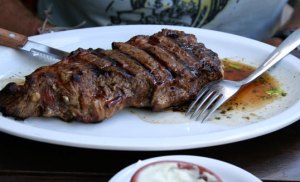 The most expensive yet finest cut is the Bife de Lomo, which means the tenderloin cut to me and you. A more popular cut is the Bife de Chorizo, not to be confused with the delicious Spanish sausage. This is the coveted Sirloin cut. Also look out for Ojo de Bife (ribeye). Forget your peppercorn sauce, steaks are served with a side of sauce called chimichurri, which is made of garlic, hot peppers, oregano, parsley and vinegar and looks a bit like pesto. The rest is up to you – bien hecho if you want it well done, al punto if you prefer it medium and poco hecho if you like it rare. Beware of creadillas which appears on most menus –these are lamb’s testicles.
The most expensive yet finest cut is the Bife de Lomo, which means the tenderloin cut to me and you. A more popular cut is the Bife de Chorizo, not to be confused with the delicious Spanish sausage. This is the coveted Sirloin cut. Also look out for Ojo de Bife (ribeye). Forget your peppercorn sauce, steaks are served with a side of sauce called chimichurri, which is made of garlic, hot peppers, oregano, parsley and vinegar and looks a bit like pesto. The rest is up to you – bien hecho if you want it well done, al punto if you prefer it medium and poco hecho if you like it rare. Beware of creadillas which appears on most menus –these are lamb’s testicles. If you have ever encountered a wine that is dull and lifeless in colour, has a musty nose, and tastes of mould with hints of wet newspaper and carpet, you probably know what it feels like to get a corked wine. The screwcap was introduced in 2001 as an answer to this problem, which affects up to 15% of all wines, depending on which expert you believe. There is still a popular myth that wine closed with a screwcap means a tacky or inferior product. These days many of the world’s best wine producers swear by them.
If you have ever encountered a wine that is dull and lifeless in colour, has a musty nose, and tastes of mould with hints of wet newspaper and carpet, you probably know what it feels like to get a corked wine. The screwcap was introduced in 2001 as an answer to this problem, which affects up to 15% of all wines, depending on which expert you believe. There is still a popular myth that wine closed with a screwcap means a tacky or inferior product. These days many of the world’s best wine producers swear by them.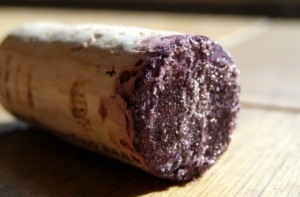 While the screwcap is ideal in that it has a perfectly air-tight seal, almost guaranteeing flavour and freshness, this isn’t entirely beneficial. The unpleasant smell of hydrogen sulfide, a by-product of the fermentation process, can become completely trapped inside a wine bottle sealed by screwcap. In general though, the screwcap has an almost zero percent failure rate. This makes it the ideal closure for most wines.
While the screwcap is ideal in that it has a perfectly air-tight seal, almost guaranteeing flavour and freshness, this isn’t entirely beneficial. The unpleasant smell of hydrogen sulfide, a by-product of the fermentation process, can become completely trapped inside a wine bottle sealed by screwcap. In general though, the screwcap has an almost zero percent failure rate. This makes it the ideal closure for most wines.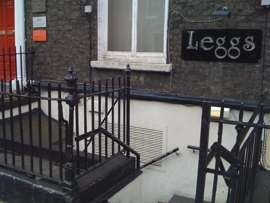 Love it or hate it, Leggs Wine Bar is one of Dublin’s most popular nocturnal haunts. The drill is all too familiar. You have enjoyed a great night out but it’s not enough. You glide past security and stumble down those cold, concrete stairs. Abandon your jacket in on the left and you enter battle. No sooner do the wonderful aromas of fast food and carpet hit you, a lovely bell-shaped glass of p*ss is thrust into your hand. It begs the question: HOW have you ended up in Leggs again?
Love it or hate it, Leggs Wine Bar is one of Dublin’s most popular nocturnal haunts. The drill is all too familiar. You have enjoyed a great night out but it’s not enough. You glide past security and stumble down those cold, concrete stairs. Abandon your jacket in on the left and you enter battle. No sooner do the wonderful aromas of fast food and carpet hit you, a lovely bell-shaped glass of p*ss is thrust into your hand. It begs the question: HOW have you ended up in Leggs again?
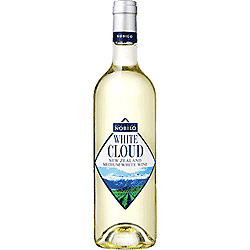 Nobilo White Cloud. Those three words should send a shudder down the spine of most regular Leggs customers. I wonder if whoever priced this wine at €39 can sleep at night because it is on sale in Sainsburys for
Nobilo White Cloud. Those three words should send a shudder down the spine of most regular Leggs customers. I wonder if whoever priced this wine at €39 can sleep at night because it is on sale in Sainsburys for 
 Have you ever seen somebody take a glass, swirl the wine around, examine it and wistfully declare ‘This wine has good legs’?
Have you ever seen somebody take a glass, swirl the wine around, examine it and wistfully declare ‘This wine has good legs’?
 Become a fan on Facebook. Tell all your friends!
Become a fan on Facebook. Tell all your friends!
